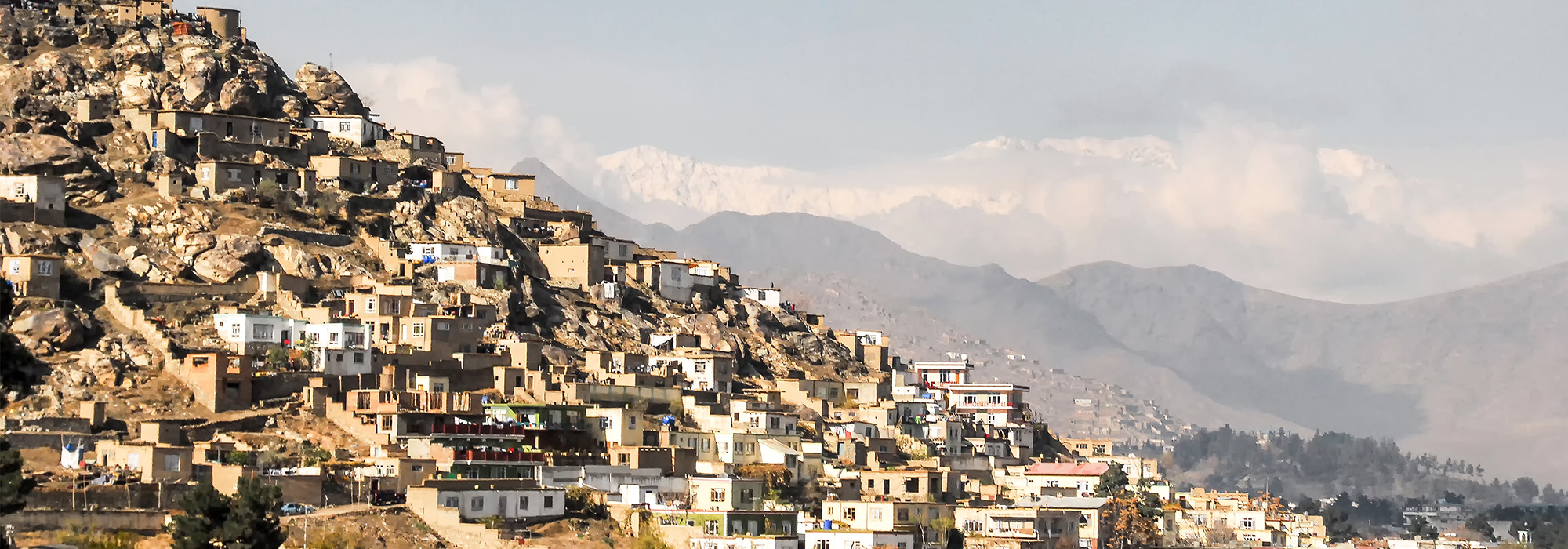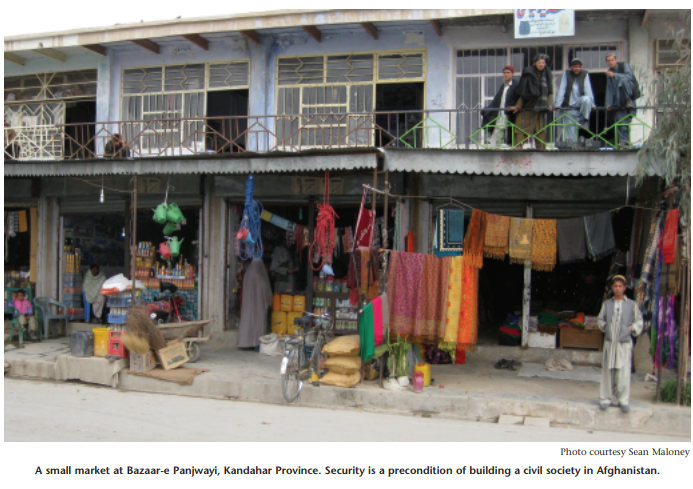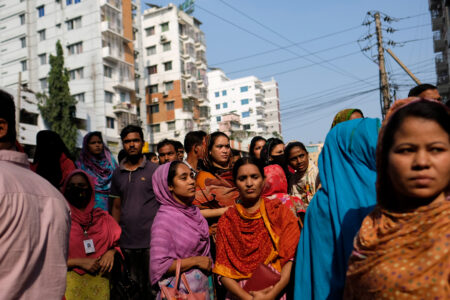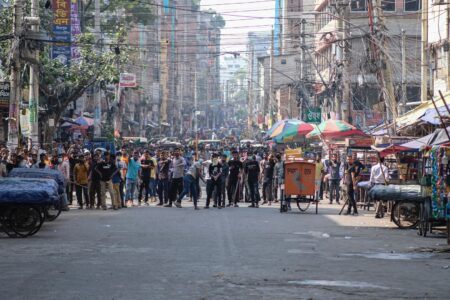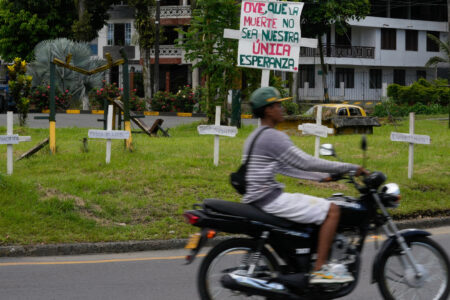
A family in Kandahar is greeted by a sun-filtered morning of Eid-ul-Fitre, the most festive day of the year for Muslims, at the end of the month-long fasting for Ramadan. This year the month was marked by extraordinary violence and thus enormous hardship for millions. The family wakes with the hope that Eid will usher in peace. The children’s wishes for Eid gifts are modest. The 12-year-old girl needs new shoes to walk to the school, if it opens when Taliban threats subside. The boy desires a hair-cut so he can go to the mosque looking prim and proper. The parents, eager to please the kids on this special day, manage to scrounge from their meagre savings a few Afghanis and send the children off to the market for the precious purchases, followed by the father.
A few minutes later there is mayhem in the road to the market, with the mangled body parts of the children strewn across the road and the glassy eyed father walking around in circles. A small news item appears in international papers with the story of another mundane suicide bombing, right under the nose of the foreign troops camped nearby.
For the children’s family, the Eid day brought destruction, never to be forgotten. Will this path of destruction ever be reversed for millions of Afghans? Will the international community’s assistance in Afghanistan, including that of Canada, be effective enough to reduce the chaos engulfing this country? The following article explores the extent to which Canadian assistance, including military assistance, given the conflict situation, is contributing to the realization of the cherished Afghan dream of peace and stability. More specifically, can Canada’s development assistance, set within the broader framework of international assistance in Afghanistan, bring what Afghans desperately need?
We have seen in the history of development that intense poverty generates conflict — often violent conflict. Poverty denies people entitlements to the basic rights for satisfying their basic needs, maintain minimum health, and acquire education and skills that help them find jobs and gain minimum purchasing power to buy basic commodities — food, housing and clothing. Lack of access to such basics creates social and political exclusion of a nature that promotes conflict in society. Conflict, if allowed to continue unabated, can create adverse conditions under which activities for development and poverty reduction are not possible. Conflict resolution, under such situations, is a precondition for effective aid delivery to reduce poverty. In Afghanistan, where conflict is manifested in terrorism, destructive of human security and all governance principles, violence needs to be contained in order to lay the foundations for effective development. This rationale connects development and military assistance, which are central to the effectiveness of international assistance missions in Afghanistan.
In Afghanistan, where conflict is manifested in terrorism, destructive of human security and all governance principles, violence needs to be contained in order to lay the foundations for effective development. This rationale connects development and military assistance, which are central to the effectiveness of international assistance missions in Afghanistan.
In Afghanistan, taking and holding land from the Taliban is of little importance, and destroying entrenched enemy positions is not relevant. Since the Taliban does not have an organized army, the combat is amorphous. The mainstay of the Taliban — supplies and help from abroad — must be cut off and the Afghan civilian population’s support must be won in favour of the Afghan government. Enabling the Afghan state to deliver basic services to its citizens and protect civilians will help the embryonic state to establish the evidence of its competence and gain legitimacy. People’s support makes a state legitimate. In conflict situations, the state’s inability to deliver basic services and security and perform governance functions results in failure of the state to earn people’s support and confidence against the opposing forces. Turning around a fragile state with weak legitimacy to stability requires building the much needed legitimacy through strengthening of state machinery and institutions to deliver the required basic economic, social and security services to the people. This is what we call “state building.” The efficacy of the international community’s Afghanistan mission is best assessed by scoring their achievements in institution-building — economic, social, political institutions — and engendering the state’s monopoly on the use of force, the combined effect of which will be delivery of development, democracy, justice, good governance and security. In Afghanistan’s case, addressing these needs is difficult and, in certain areas, impossible, unless security and freedom from intimidation and threats from the Taliban are attained through application of military force, initially through the deployment of foreign troops. For sustained stability, development of the institutions of the Afghan army and civilian police is essential to allow gradual withdrawal of foreign troops.
For an assessment of the effectiveness of Canada’s assistance (within the envelope of international community’s assistance) to Afghanistan, the issues we have to address are: has our military involvement successfully generated a secure environment for development delivery? and to what extent has Canadian development assistance been able to create or strengthen the state institutions that should perform the tasks of delivering basic services, good governance and human security to its citizens. The answer may not prove to be very positive. And this conclusion is correct not only for Canada but also for most other Western nations involved in Afghanistan.
Enduring peace and security is elusive after eight years of the international community’s military and development involvement. The clear-hold-build strategy has not succeeded. Insecurity has intensified, extended and expanded across the country, even to provinces that used to be relatively secure. One only needs to review the escalating figures of suicide bombings and improvised explosive device (IED) attacks and the resulting civil and military deaths this year alone. Afghan ministries (with a handful of exceptions) remain weak and unable to deliver essential services to the public — ranging from basic services and income, to justice and human security. A prime example of the failure to build institutions is the fiasco with the recent election, heavily internationally funded for nearly $300 million. Canada and other Western nations financed the Independent Election Commission but failed to strengthen it to operate a free and fair election.
What have been the shortfalls historically?
- No clear objective was established after the initial suppression of the Taliban in 2001;
- Programming was not past evidence or reality based;
- Incorrect aid delivery mechanisms were used that violated the commitments made by the OECD countries in 2005 in Paris to abide by the aid effectiveness principles;
- Donor coordination was unsatisfactory.
Legitimacy- and state-building operations in fragile states must begin with clear objectives and a clear strategy — both long and short term. The international community started in Afghanistan with confused objectives at best. Were the objectives homeland and Afghanistan’s security and elimination of a safe haven for terrorists? Was it protecting women’s rights? Was it establishing democracy? It was never clear. If these were the objectives, none has been achieved.
Canada entered Afghanistan tagging its operation with the fashionable banner of the “3-Ds,” implying development, diplomacy and defence cooperation. But the 3-Ds were not backed up with a clear definition of the term, especially in the context of the new conflict zone Canada was entering. No unitary objective was established and no division of functions between the 3-Ds to achieve the objective was envisaged.
The result was confusion, with the limited resources of the 3-Ds not complementing each other and the defence and development wings overlapping and sometimes duplicating activities. More recent adoption of the “whole of government approach” appears to have achieved improved coordination, but one wonders if it might be too late. Canada does not yet have a strategy, although it has an action plan based on benchmarks that are not clear on outcomes but are marked for activities completion, which does not help determine the efficacy of the actions taken.
What results have the 3-Ds achieved?
The major objective of the diplomacy wing should have been information-gathering on the sensitive areas in Afghanistan showing signs of agency; keeping an eye on the border areas with Pakistan; considering means of regional cooperation; advising to influence the Afghan Transitional Government on the need for reconciliation with the insurgent groups at a time when the Afghans and their international allies were in a position of strength; and mentorship and oversight of security sector and governance reforms. There was little sign of diplomacy focusing on these issues in the early years following 2001. Canada claims to be involved in some of these activities now. Indicators to scrutinize progress towards results in these areas should be established and used for reporting.
For rational reasons, the political and diplomacy wing mentored, mostly aid-financed, the following security sector reforms and measures: heavy weapons cantonment; demobilization and disarmament and reintegration of ex-combatant regular militia (DDR) to contain violence; disarmament of illegal armed groups; the Afghanistan stabilization program for strengthening local governance; justice reforms; police reform; and democracy promotion. Heavy weapons cantonment had some initial success. The demobilization and disarmament part of DDR was successful, but in the absence of appropriate programming and oversight, reintegration was not achieved and, in the course of time, it was transformed into “rearmament.” Corruption drew the Afghanistan stabilization program to a close and Canadian funds were withdrawn. Access to justice is close to non-existent to this day and no unitary legal order exists. The police remain corrupt and unable to win the trust and confidence of the people. Although the first presidential and parliamentary elections were admittedly free and fair, in the absence of democratic institutions — justice and court systems, and an uncorrupt civilian police force — the democratic rights of the people could not be protected. Thus, democracy promotion remains an illusion, as indicated by the recent election fiasco.
For defence programming, with no clear short-term, not to speak of long-term, objectives in view, quick and visible fixes became the order of the day for most countries contributing troops. Building schools, roads, wells and pumps, not delivered by the Afghan government but by foreign troops, might win the hearts and minds of the people temporarily for foreign forces’ protection. But such efforts fail to raise the visibility or profile of the Afghan government to its people for earning legitimacy. There is a fundamental flaw in the argument for actions to protect the foreign troops. As US General McChrystal argues, protection of the people, not the forces, is a priority. Canadian Ben Roswell in Kandahar recently announced that our involvement is all about the people of Afghanistan and their protection. In the absence of such analyses underlying our programming, we may continue to see plenty of examples of QIPS (quick impact projects) turning into NIPS (no impact projects).
Training the army, which Canada has now taken up, might prove to be effective in the long term. But few, if any, units of the army are yet strong enough to resist aggression independently, without the support of foreign forces. Some people are of the opinion that strengthening the Afghan army with transport and armed equipment will enable the army to act independently. But will it?
Linked in with inadequate effectiveness of the diplomacy and defence efforts are the deficiencies in the development aid system, further reducing donors’ ability to attain positive results for poverty reduction and institution building. The deficiencies include programming not based on a political economy approach for job creation and income generation; incorrect aid delivery mechanisms not harnessing or further strengthening available capacity within Afghanistan; and reneging on commitments made by the international community in Paris in 2005 to address the aid effectiveness principles meant to introduce criteria for operation of an effective aid system. Other than exceptional donors like the UK Department for International Development, the international community largely ignores the aid effectiveness principles of country ownership, multi-year aid commitments, alignment with country-managed budget and related systems based on mutual accountability, harmonization of donor efforts for concentrated development impact, and managing for those development results that will benefit the people.
In the absence of any clear objective or multi-year financing, programming in the early years was random for Canada. There was random direction from the headquarters to terminate successful programs, without appropriate rationalization, new programs were financed without longer-term vision but chosen because they were perceived to have political clout in the capital. One of the potentially damaging proposals (fortunately never approved) was to support poppy production for medicinal purposes — poppy cultivation is illegal under the Afghan constitution. Canada invested millions in an NGO project that transferred back to Canada 80 percent of the funds. Critics were asked to turn their eyes away as the implementing organization apparently had political support, and so it did, both in Canada and in Kabul. Bankruptcy of the organization eventually saved the Canadian tax payers and Afghans.
Development assistance continues to be politicized, as is clearly reflected in the prescriptive and self-serving nature of aid, supporting Canadian political and military objectives and directing a disproportionate amount of aid funds to Kandahar, where Canada’s troops are fighting the insurgency. Little evidence exists of such investments contributing to establishment of security in the province. Canada’s announced policy is to invest 50-60 percent of its aid in Kandahar. Such a policy directly contradicts Afghan leaders’ expressed interest in nationally balanced development, the argument being that while southern and eastern Afghanistan demand special focus because of their geographic proximity to Taliban safe havens and their subsequent vulnerability, this should not come at the cost of neglecting central and northern Afghanistan. Resources allocated for and revenues generated in Afghanistan should be shared equitably among all the people of Afghanistan. Countering this rationale the Canadian-funded Model Village in Kandahar is promoting unbalanced development, judged in this context of the underdeveloped peripheries. Such models are not replicable and certainly are not sustainable after the departure of the funders.
In contrast, some Canadian-aid-funded Afghan government programs have been successfully delivered to the people. Significant positive results have been achieved to date from government-led programs in social sector development — education, health, rural development and agricultural planning. Canada had the wisdom to fund several such national programs. Alas! The wisdom was lost with the brilliant concept of the “signature” projects, with Canadian stamps in them because in the absence of Maple Leaf stamps, the Manley Commission found Canada invisible in Afghanistan. Visibility of the Afghan state in the delivery role was not a consideration. Canada moved away from the programming approach to financing Afghan national programs and switched to programming and funding through mechanisms parallel to that of the government, which goes against the commitment Canada made in Paris in 2005 to follow the aid effectiveness principle of investing in country-led development programming. The lessons to be drawn from the successful national programs is that they address the need to establish government’s credibility of delivering services to the people and meet the first principle of aid effectiveness — recipient country in the driver’s seat. The concept of signature projects, pushing Canadian visibility, does nothing to earn longer term legitimacy for the Afghan state institutions and violates the local ownership principle.
At the base of the state building agenda lies capacity building, also high priority for promoting effectiveness of aid. With nearly $2 billion invested in capacity building, the international community has failed to build sustained capacity in the critical Afghan institutions. Little is known about the ethically and tactically wrong practice of the international community channelling close to 40 percent of total aid funds to benefit costly expatriate consultants, living off the “aid industry,” and yet it is unable to build capacity. Technical assistance has been largely supply driven, controlled by donors, instead of being demand driven.
In capacity and institution building or other areas, the international community has traditionally had little shared vision, much less of a common strategy; thus billions of dollars of aid has little concentrated impact. Such an approach fragments international aid efforts and violates the harmonization principle of aid effectiveness. Some of the Afghan government’s successes, such as the benefits accrued from the National Solidarity Program (to which Canadian funding has been drastically cut), bear evidence of the extent of success that can be reached with harmonized and well coordinated donor support to and investment in Afghan initiated and managed programs. The legitimacy crisis of the Afghan state could be alleviated with a coordinated donor strategy supporting the best Afghan-led programs. Instead, donor domination of Afghanistan’s development programming has tilted the process of nation building into a decline that might prove to be irreversible.
To date, approximately 80 percent of Afghanistan’s development budget remains external to the government’s budget process, preventing Afghanistan from investing major portions of aid funds in state-identified development priorities. Since the invention of the signature projects, Canada has drastically reduced financing of government projects when it does not deter from generously supporting well resourced private foundations such as Turquoise Mountain, a UK-based organization. The leadership of this organization disputes the need for state building. The organization’s program includes reviving Afghanistan’s cultural heritage — a laudable objective, but not a dire necessity at this time amidst increasing insecurity and poverty. Afghanistan ranked 181st out of 182 countries in the 2009 global Human Development Index, indicating a consistently steady decline in composite measures of development since 2004.
Letting the government manage aid budgets helps develop capacity in public finance management, which should help curb endemic corruption. Just for the sake of tracking each donor dollar, parallel project interventions and their management by donor contracted agencies compete with government delivered programs and fail to give the government the opportunity to learn by doing and building its own capacity. If need be, tighter accountability requirements could be established by the donors, for instance asking for oversight by an independent Afghan auditor general. Accountability must also be mutual between the donors and the government. Many donors are known to violate the mutual accountability principle of aid effectiveness by refusing to provide information to the Afghan government on funding amounts, objectives, activities and the results of projects they implement in Afghanistan.
A conclusion to be drawn from this review is that international aid and military assistance, including Canadian aid, have not been effectively deployed in Afghanistan. The counterinsurgency is not going well, as clearly reflected in the escalating and expanding insecurity. When US General McChrystal drew a grim security picture, Canada’s top military commander, Lieutenant-General Marc Lessard, admitted the seriousness of the situation, although he believes that the war is winnable. It is difficult for a civilian to determine if it is winnable in the face of the grim statistics and the picture painted, even in Canada’s most recent quarterly report.
Are the rebuilding efforts, in terms of creating a competent and legitimate government, going well? Are credible institutions being developed? Canada’s quarterly reports mostly speak of activities completed, from which it is difficult to assess outcome results in social and economic development, human security or state building. To cite some examples of Canadian government’s reporting: in Dhala Dam, many Canadian consultants and experts have been hired and SNC Lavalin is being paid for its services; but are jobs being created for Afghans in the region? Are the five schools built in the Kandahar province operational, with students enrolled? Are the trained teachers deployed in schools for strengthened delivery of education? Such information would be welcomed by the Canadian public. Will these outcomes be achieved in the longer-term? The need for longer term involvement of the international community in fragile situations is undeniable. This by no means suggests the extension of Canadian presence in the same shape and form beyond 2011, which was rejected our Parliament.
In support of the need for longer term international involvement in general in Afghanistan, comparison of the counterinsurgency in Afghanistan with the Vietnam War should be recognized to be invalid. Other than the potential of getting entrenched in a long unwinnable war as a result of neglect and incorrect approaches, thus promoting a perception of foreign occupation of the country, there are no other similarities between Vietnam and Afghanistan. No ideological debate is required to recognize the reality that Ho Chi Minh was not Mullah Omar; and no stretch of our imagination would allow us to equate the Viet Cong movement with the jihadist Taliban movement, based on terrorism. The Taliban movement does not represent popular resistance to the Afghan government or the foreign troops. Abandoning Afghanistan at this stage is certain to result in a Taliban takeover of the country and to clear the field for al-Qaeda’s return. Do we want to leave a clear playing field for international terrorism to be nurtured?
Thus, a cut-and-run strategy is not recommended. But also not recommended is denial of the glaring problems we encounter, using the excuse of lack of resources. It is wrong to claim that success is only a door away if the international community is adorned with “more” — more time, more troops, more aid, and more civilians. A drastic change in the attitude and strategy of the international community in Afghanistan is essential to make the mission effective for stabilizing the country. I echo General McChrystal’s caution when he asked for more troops — the international Afghan mission should not be further resourced without a changed strategy.
A changed strategy will have to be focused on the welfare of Afghan civilians, providing them with human security, which includes protection against threats, aggression and intense poverty, while harnessing and strengthening existing Afghan capacity to deliver public goods and services, which constitute the basic responsibility of all legitimate states to its citizens. A sequential path might have to be carved out for the very insecure southern and eastern regions, where suppression of the Taliban insurgency should be the first requirement prior to delivering aid at enormous costs in the absence of security. Simultaneously, for the northern and western regions, efforts should focus on preventing Taliban expansion, while delivering basic services through state institutions, and providing access to jobs and income. Support for the state for revenue mobilization and institution building for basic service delivery will gradually reduce Afghanistan’s dependence on external assistance. To ease the exit of the international community, the strengthening of the armed forces and a civilian police force are of equal importance. In aid delivery, the aid effectiveness principles that the international community committed to in Paris in 2005 and in Accra in 2008 must be observed. Adherence to aid effectiveness principles encompasses building the capacity of the local partners, including the capacity to control corruption. Lack of capacity of our partners should not be used as an excuse for operation of parallel donor designed and managed programs. The option of reconciliation with the Taliban appears to be less favoured at this time, when the Taliban is gaining momentum, because negotiating from a weaker position will not achieve the desired results for the Afghan state.
But weakening of the Taliban, which is not a monolithic body, by paring off those who are not ideologically committed Talibs from the mainstream Taliban has some potential, until Afghanistan and its international allies are able to talk to the staunch Taliban from a position of strength. A holistic strategy indeed needs regional cooperation — the assistance of China, India, Pakistan, Iran, and also Russia. The Obama administration is reviewing these issues to come to a decision on further troop surges.
Building a strategy with clear objectives and expected results and harmonizing international support in implementing this strategy, in partnership with credible Afghan leaders, are urgent priorities. Diligently monitoring progress toward the outcomes of the strategy will be an essential requirement. In the absence of appropriate monitoring of results, with indicators, we are caught in a worse situation in 2009, eight years after the launch of the mission for enduring peace. Due diligence is essential in order that we do not end up in 2011 (citing only Canadian army’s exit year) with the status quo or any further decline.
Photo: Shutterstock



